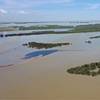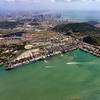America's Western River: A Unique Security Challenge
Since 9-11 all facets of the media have combined to focus national policy makers, in and out of government, along with the general public on the asymmetric terrorist threat facing the United States and its global trading partners. Lengthy newspaper articles or Op-ed pieces, documentaries on television such as The Learning Channel and the Discovery Channel, along with talk radio banter have spotlighted multiple areas of concern. These have included airplanes, tanker trucks, critical infrastructure and the country's bustling seaports such as New York and Los Angles. The maritime nexus in particular has received a lot of attention as over 90 percent of the nation's commerce travels by water. "Experts" have looked at ferry security, security around nuclear power plants and ways that the general public can get involved in the national effort. Commentaries on how vessels could be used as weapons, or the latest on container security have migrated from the maritime trade publications to the national media. The vast majority of this coverage on maritime security has been devoted to the coastal ports and terrorist attacks that originate from outside the U.S., but very little has been written about the nation's efforts to secure the Western Rivers, the lifeline of America's heartland. This article provides a synopsis of the multi-agency effort that secures our inland rivers. As the Lead Federal Agency (LFA) for Maritime Homeland Security, the Coast Guard has coordinated a multi-faceted effort using Federal, state and local agencies as well as private industry to secure the U.S. maritime domain. The service has adopted an overarching security goal of preventing terrorist attacks within or exploitation of the U.S. maritime transportation system (MTS). To accomplish this the Coast Guard with its many security partners have implemented a risk-based approach to identify and secure critical infrastructure within the MTS and to target possible threats to maritime security. To this end, the Coast Guard is partnering with the rest of the intelligence community to identify possible threats well before they reach U.S. shores. The result is a multi-layered, multi-agency international security operation that attempts to intercept terrorist activities overseas, again at the nation's entry points and once more in the vicinity of critical infrastructure while hardening the physical security at these pieces of infrastructure to withstand an attack should all else fail. A strategy that must be implemented within the constraints of fiscally responsible budgets, preservation of civil liberties and ensuring the flow of legitimate maritime commerce so vital to this nation's economy. Security of the Western Rivers, led by the Eight Coast Guard District, is an important component of this maritime homeland security strategy. The vast expanse of the Western Rivers consisting of 41 rivers and lakes across 18 states throughout the heartland of the United States poses a tremendous security challenge. This inland MTS centers on the Mississippi River and its major tributaries including the Ohio, Illinois, Missouri, Arkansas, Tennessee and Cumberland Rivers (over 10,300 miles of navigable waterways). These rivers flow through the states of Pennsylvania, Ohio, West Virginia, Kentucky, Nebraska, Tennessee, Indiana, Arkansas, Iowa, Kansas, Missouri, Oklahoma, Louisiana, Mississippi, Alabama, Illinois, Minnesota and Wisconsin. These waterways are an integral part of a complex inter-modal transportation system, which moves bulk cargoes and manufactured goods for foreign and domestic commerce. They provide a channel into the nation's heartland, connecting the Gulf Coast with the coal and steel industries of Pittsburgh, Pennsylvania; and the grain exporters of the Twin Cities, Minnesota. The inland waterways system allows the competitive movement of huge quantities of liquid and dry bulk cargoes between deepwater ports and distant points of production or consumption in the nation's interior. In recent years, U.S. inland waterways traffic has approximated 630 million tons annually)-accounting for about 15 percent of total intercity commerce by volume. Total inland waterways traffic is forecast to increase 1.3 percent annually to more than 836 million tons by 2020 with principal commodity groups including coal, petroleum, farm products, chemicals, and crude materials, such as aggregates for construction and other minerals. Each inland barge carries as much cargo as 150 tractor-trailer trucks or 40 rail hopper cars. A typical tow of 15 barges has the capacity of 2,250 trucks or 600 rail cars. The Federal Highway Administration estimates that for each 1 million tons of coal diverted from barge to truck, 45,600 additional trucks would be needed to move the coal. The Tennessee Valley Authority estimated the average transportation savings of shipping by barge versus alternate mode of transport to be $6.92 per ton for coal, $29.65 per ton for chemicals and averaged $10.54 per ton for all cargo. The inland waterway cargo-carrying fleet includes 2,500 tank barges. There are also 25,000 dry cargo barges. A fleet of 5,200 towboats and tugboats supports the barge fleet. The fleet travels the inland waterways by using more than 170 lock sites. There are more than 1,700 river terminals along the Western Rivers. 59 percent of inland terminals are grain, coal and other dry bulk facilities. Liquid bulk terminals account for 27 percent; half of which are petroleum facilities. The terminals on the inland system are less concentrated geographically and provide almost limitless access points to the waterways.
The task of securing this transportation system is perhaps one of the Coast Guard's most complex challenges. Not only are multiple jurisdictions involved, the sheer length of the transportation system is daunting. To respond to this challenge the Coast Guard through the Eighth Coast Guard District command located in New Orleans has initiated three major programs, which when combined, significantly increases maritime security, maritime domain awareness and interoperability with the public and commercial operators. In perhaps one of the most under publicized homeland security initiatives, the Inland River Vessel Movement Center (IRVMC) was created. In response to direction from the Department of Homeland Security and in consultation with the maritime community operating on the rivers, IRVMC, located in St Louis, was established in 2003 to help develop greater maritime domain awareness (MDA) on the Western Rivers through the tracking of Certain Dangerous Cargoes (as specified by regulation) that are carried in barges. Each year IRVMC tracks over 36,000 transits of barges carrying these hazardous cargoes, at 94 individual reporting points, over 10,300 miles of the inland rivers, including thousands of transits through High Density Population Areas. Commercial operators report the location of barges carrying specified cargos to the IRVMC either electronically or manually. IRMVC provides this information to the inland river Coast Guard Captains of the Port (COTPs). The COTPs then are able to schedule security boardings and escorts based on individual risks associated with the movement of the cargo through specific regions of the country. The information provided by IRVMC is essential to the Western Rivers Maritime Security mission and provides the only MDA within the inland rivers system. A second initiative was the Louisiana River Watch Program a joint effort between the Eighth Coast Guard District and the Louisiana National Guard. Based on the tenets of the Neighborhood Watch Program, this awareness program asks those who work, live, or recreate on or near the water to be aware of suspicious activity that might indicate threats to our country's homeland security. Citizens are urged to adopt a heightened sensitivity toward unusual events or individuals they may encounter in or around ports, docks, marinas, riversides, beaches, or communities. Anyone observing suspicious activity is simply asked to note details and contact local law enforcement. In 2004, the Coast Guard expanded the Louisiana River Watch and other similar programs to the national level renaming this partnership with the public as America's Waterway Watch. This collective national action is designed to increase the awareness of all Americans to suspicious activities on or near our coastlines and river systems. The third initiative was the establishment of the Western Rivers Area Maritime Security Committee. A quick look at a national map reveals that the Western Rivers system includes six ports that have been identified as economically significant: Memphis, Louisville, St. Louis, Pittsburgh, Cincinnati and Huntington. Paducah, although not a designated economically significant port is located at the confluence of three major rivers, is a major thoroughfare and has considerable infrastructure. Chartered in January of 2004 the Western Rivers Area Maritime Security (AMS) Committee was chartered in accordance with the Maritime Transportation Security Act of 2002. This Committee provides a forum for port stakeholders in the Western Rivers Region to work together in facilitating the Coast Guard's Ports, Waterways, and Coastal Security (PWCS) mission to deter, detect, prevent and respond to attacks against U.S. territory, population, and critical maritime infrastructure. The Western Rivers AMS Committee functions as the regional AMS Committee for the Western Rivers Region. As such, it incorporates the geographic boundaries of the COTP zones of Pittsburgh, Huntington, Paducah, Louisville, St. Louis, and Memphis, as described below. In addition, certain river portions of the COTP zones of Chicago, Mobile, and New Orleans are incorporated into the Committee. The Committee's mandate is to assure consistency in:
(1) Identifying critical port infrastructure and operations. (2) Identifying risks (threats, vulnerabilities, and consequences). (3) Determining mitigation strategies and implementation methods. (4) Developing and describing the process to continually evaluate overall port security. It also provides a forum to work through differences and allow all stakeholders with a certain port to "get on the same sheet of music." Finally, the AMS Committee prepares and maintains the Western Rivers Area Maritime Security Plan, referred to as the "WRAMS Plan." The WRAMS Plan addresses port security issues and security operating procedures common to all COTP offices in the region while incorporating annexes developed by the individual COTPs and their Area Maritime Security Subcommittees to address port-specific concerns. The regional committee and its subcommittees are critical platforms for the COTPs, as the Federal Maritime Security Coordinators (FMSCs), to coordinate multi-agency and private sector security efforts in accordance with the Maritime Transportation Security Act. These three Coast Guard led initiatives have paid large dividends toward providing maritime security for a diverse wide-ranging and vital part of the country's MTS. The end result has been a much better prepared, coordinated and informed federal, state, local and private sector security partnership operating in unison to ensure the safe and secure flow of commerce along our inland waters. The Coast Guard's Western Rivers initiatives, including bold steps toward maritime domain awareness and maritime security must continue to be strengthened and matured.
About the authors Rear Admiral Robert Duncan is the Commander of Coast Guard District Eight, Captain Ron Branch is the Chief of Operations for Coast Guard District Eight, Mr. Chris Doane is Coast Guard Atlantic Area's Chief of Port Security and Response, and Mr. Joe DiRenzo III is Coast Atlantic Area's Anti-Terrorism Coordinator. Mr. Doane and Mr. DiRenzo are frequent contributors to Marine News.











